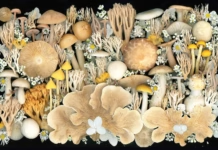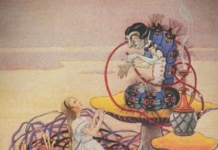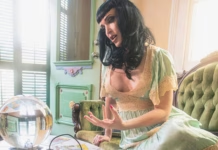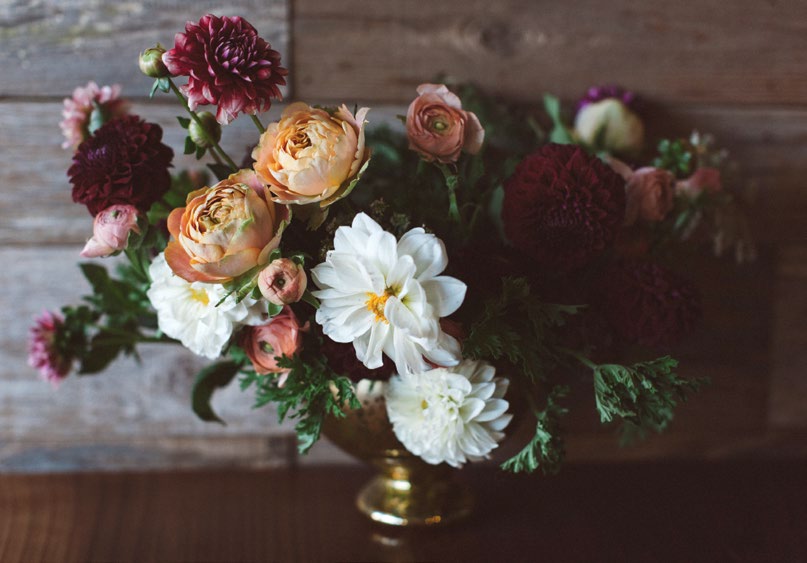 ADVICE FROM A FLORIST by
ADVICE FROM A FLORIST by
LARISA MINERVA
FLORAL PHOTOGRAPHY by
JUSTINE GRAJSKI
Flowers speak in ways that words fail us. They arrive in spring, pushing their eager green heads through the snow to greet us, welcoming us into another year. Each season is marked by specific blossom varieties, evolving along with us throughout the year, enchanting us with color and fragrance. Then, as autumn fades into winter, they dissolve back into the land, delicate reminders of the temporality of all things, small prayers from the earth to begin the cycle again.
The Victorians knew full well this secret language and sent one another handpicked messages of both love and disdain. According to a book of flower code, each color and variety stood for something far beyond its beauty: hydrangea for gratitude, lavender for mistrust, ranunculus for radiant charm—the list goes on. Although this language has been largely forgotten, the specific correlation between word and flower antiquated, I like to think that with each bouquet delivered, each bride adorned, each stem wrapped, a quiet message is still sent.
As a florist for the past five years, I’ve seen it all, from birthdays to weddings, anniversaries to funerals, baby showers to prom corsages. Flowers accompany every significant life event. And yet far too often I receive customers in my shop who have no clue what they’re looking for.
“What’s the occasion?” I probe. “What types of flowers or colors does the recipient like?” It shocks me how many husbands have lived and loved with their wives for years without knowing the color palette to which their bride is inclined.
“Just make something pretty,” they instruct, wanting as little involvement as possible. They’re paying customers, so I’m happy to oblige, but it makes me squirm inside to think I’m composing a love note from a man to a woman I barely know. Does she love wild arching greens or tight compact bundles of lace and color? Does she want exotic shapes and colors that require a scientific inquiry to obtain their names, or does the simplicity of sunflowers make sense to her?
So much remains unanswered even with the most sophisticated customer, and it occurs to me that what has become intuitive for me is often unknown to the general public. To help alleviate the strangeness, here is my guide for flower gathering—both from your local florist and out in the wild.
FLOWERS ARE SEASONAL
No, you cannot get peonies in September. No matter how much you spend, how far you’re willing to import from, how much she loves them, man has not been able to grow
a peony outside of its strict growing season: May and June in the northern hemisphere, November and December in the southern. And yet I’m asked for them all year round.
“Sorry,” I want to reply, “but even I cannot control nature.”
The flower industry, like the food industry, has forced its way around these limitations: hydroponics and greenhouses, genetic modification and breeding, excessive pesticides and flights around the world in refrigerated containers. You name it, they’ll do it—for a price. In the quest for the perfect long-lasting blossom, concerns for human health and well-being have been ignored and regulations for pesticides lax—especially in poorer countries—since flowers are not consumed like produce. And yet the first thing most of us do when we receive a bouquet is lean in and take a big whiff of the enticing scent.
More recently, enough people have called these practices into question to create change. The slow-flower movement, following on the heels of the slow-food movement, caters to consumers who recognize flowers as a luxury good that should not enslave workers and harm the environment for the sake of profit, especially when gorgeous blossoms spring
up on the sides of roads and in your local farmers’ fields.
Though equally as beautiful, there is a distinctly different look when you choose slow flowers. While imported Colombian roses offer rows of uniform, oversize, color-drenched product, wildflowers and heirlooms are often smaller and imperfectly formed, but each face is unique. Each farmers’-market bundle yields a surprise in color, each wildflower sculpted by its particular growing conditions. When shopping for flowers, ask your florist if they have any locally grown flowers and see how they differ from the rest of the offerings. If you’re fortunate enough to live in a large flower-producing state like Washington or Oregon, it’s possible that the majority of your local shop’s stock is from nearby farms. If not, try the farmers’ market.
I can’t speak for everyone, but I really appreciate when my customers ask me questions about styles and origins. Usually your florist can help you discern if a flower is in season. If it’s not the right time for a certain variety, it will be more expensive, of poorer quality, or not available at all. If you have some knowledge of the seasonal offerings, it will help you determine which are imports and may not last as long. Although availability varies depending on where you live, as a general rule of thumb you can expect the following:
In early spring, expect delicate bulb blossoms like paper whites and narcissuses, the first of the tulips, and blossoming branches like cherry and magnolia. As we move into full spring, it’s all about the bulbs: hyacinth, freesia, ranunculus, anemone, in full color and fragrance. Late spring brings the aforementioned peonies, which can have a rich scent when locally grown, as well as garden roses, lilacs, and lilies, the big showy blossoms. This is prime flower time. As the temperature heats into summer, think field flowers, scabiosa, snapdragons, sunflowers, zinnias, amaranth, dahlias, and hydrangea. Things taper off into autumn, and florists often start getting into rich foliage-based designs, but you can still find mums, some dahlias, and hydrangea, along with rose hips and alstroemeria. At the end of the year, the holidays are accompanied by wintergreens and amaryllis along with fruits like citrus and pomegranate.
Use your best judgment. Although some damage to flowers is unavoidable in transport, you can tell if a flower will last much longer based on how it looks. If the stems look moldy, the petals soft or wrinkled, or the leaves browning, then the flower probably won’t last. Also be wary of flowers stored in coolers all day. If they’ve spent their entire cut life in a fridge, it’s likely they won’t be able to handle sudden heat.
































